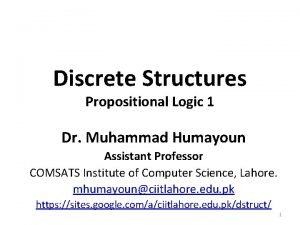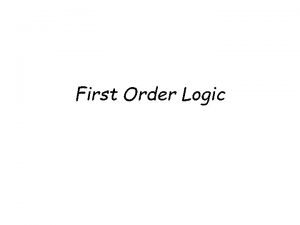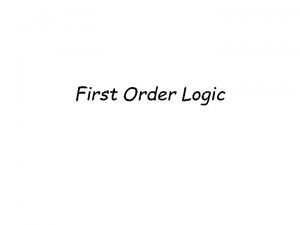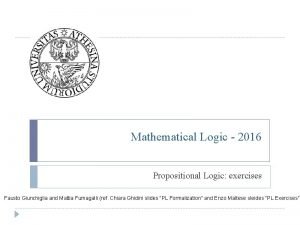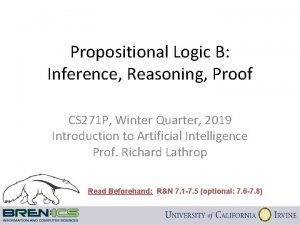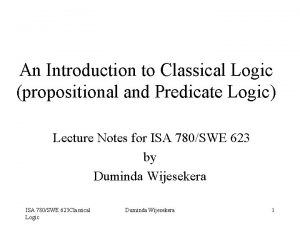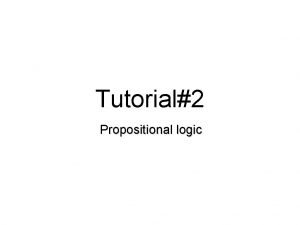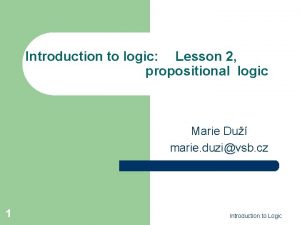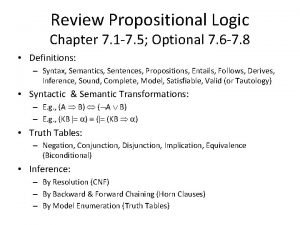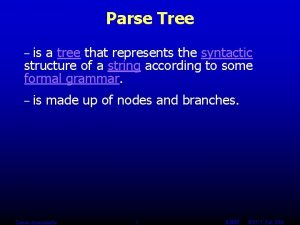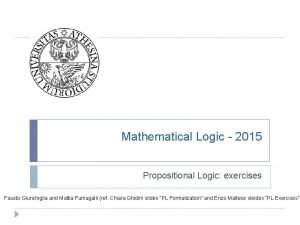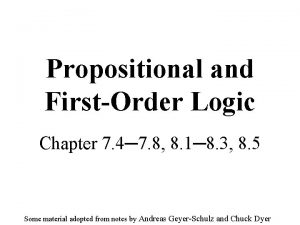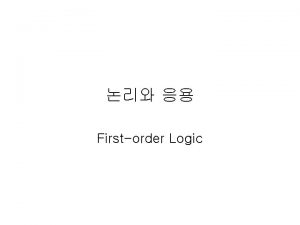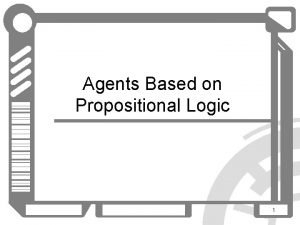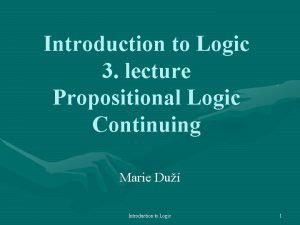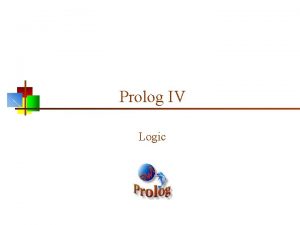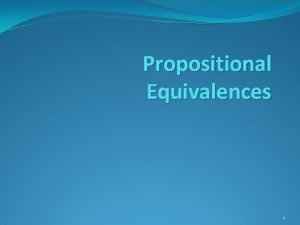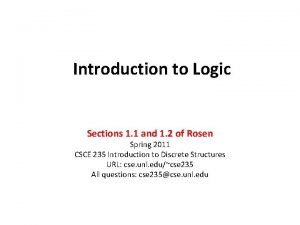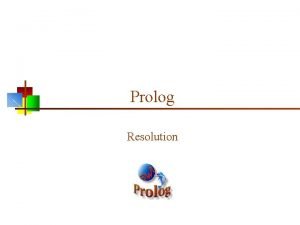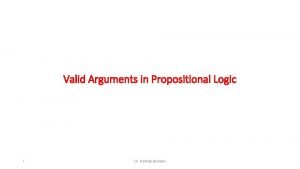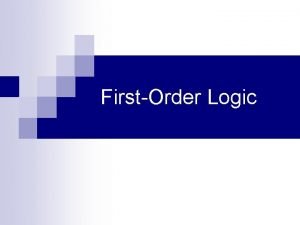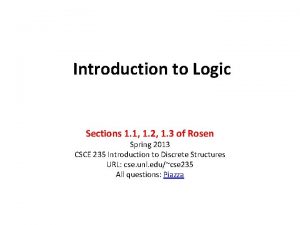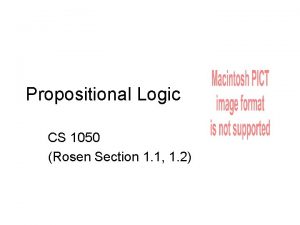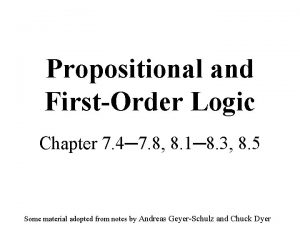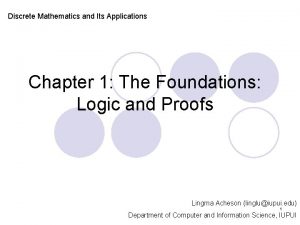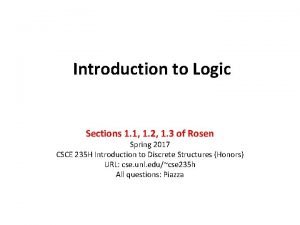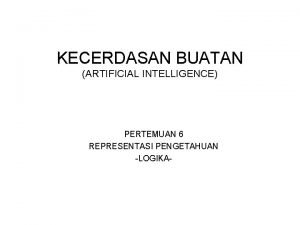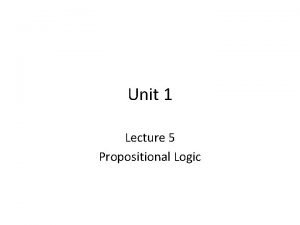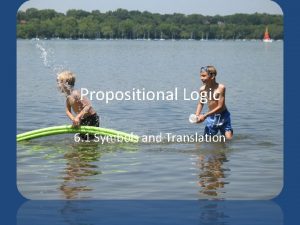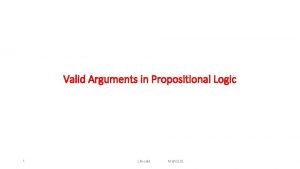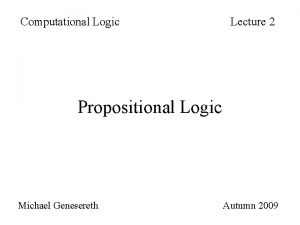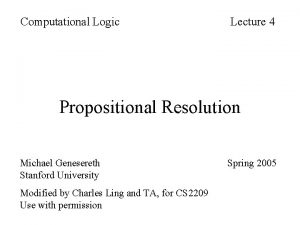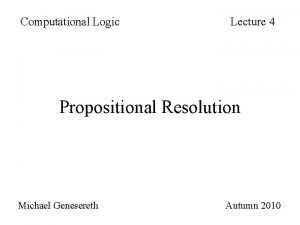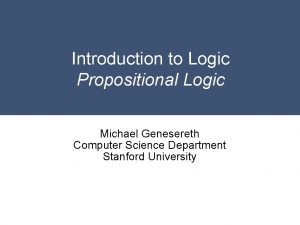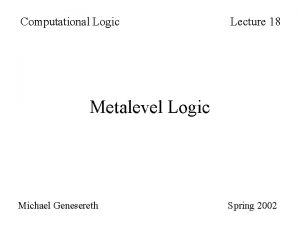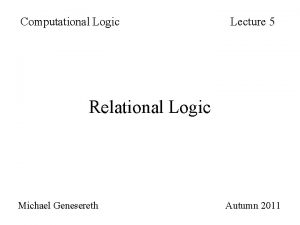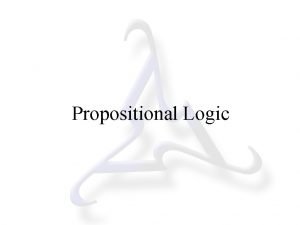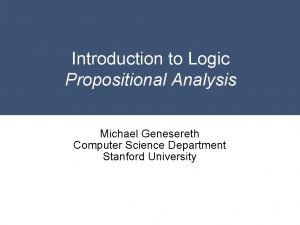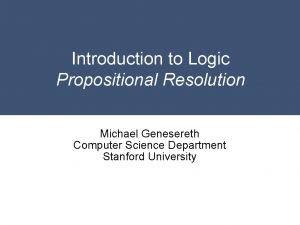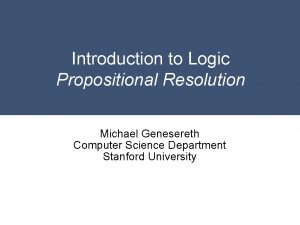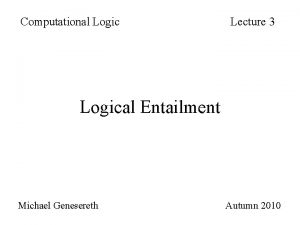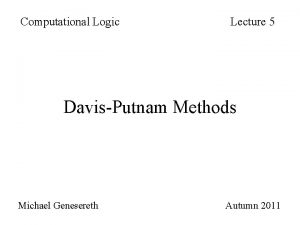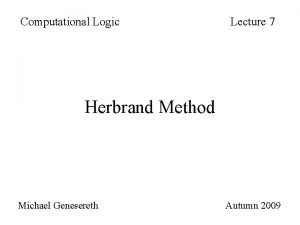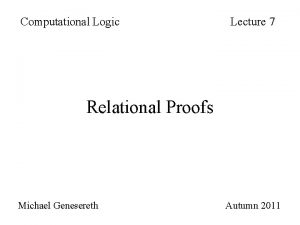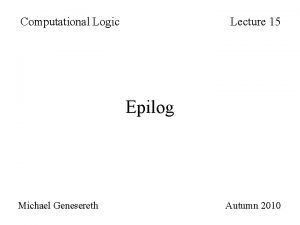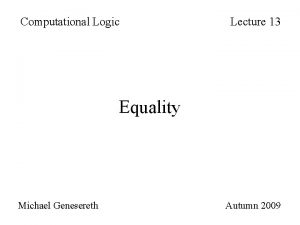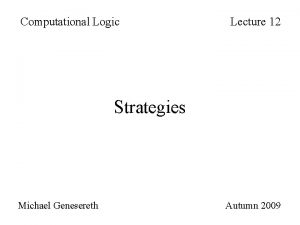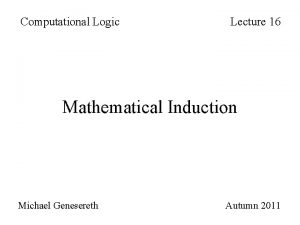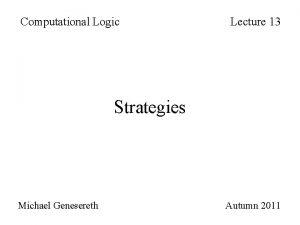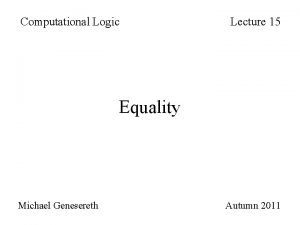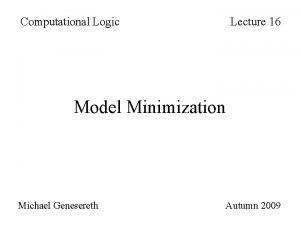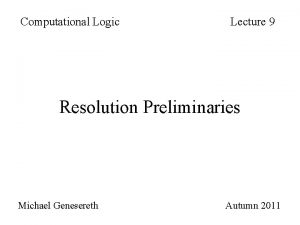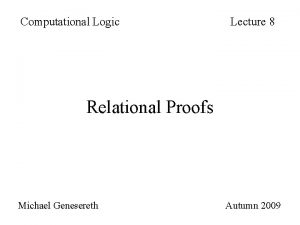Computational Logic Lecture 2 Propositional Logic Michael Genesereth





































- Slides: 37

Computational Logic Lecture 2 Propositional Logic Michael Genesereth Autumn 2009

Ambiguity There’s a girl in the room with a telescope. 1/21/2022 2

Complexity The cherry blossoms in the spring … sank. 1/21/2022 3

Misleading Representation Champagne is better than soda. Soda is better than swill. Therefore, champagne is better than swill. Bad sex is better than nothing. Nothing is better than good sex. Therefore, bad sex is better than good sex. 1/21/2022 4

Propositional Languages The signature of a propositional language is a set of primitive objects, called propositional constants. The sentences in a propositional language consist of (1) the propositional constants in the language’s signature together with (2) compound sentences composed of simpler sentences. (Details to follow. ) 1/21/2022 5

Proposition Constants Proposition constants are written as strings of alphnumeric characters beginning with a lower case letter. Examples: raining r 32 aining r. Ai. Ng rainingorsnowing Non-Examples: 324567 raining. or. snowing 1/21/2022 6

Compound Sentences Negations: raining The argument of a negation is called the target. Conjunctions: (raining snowing) The arguments of a conjunction are called conjuncts. Disjunctions: (raining snowing) The arguments of a disjunction are called disjuncts. 1/21/2022 7

Compound Sentences (concluded) Implications: (raining cloudy) The left argument of an implication is the antecedent. The right argument is the consequent. Reductions: (cloudy raining) The left argument of a reduction is the consequent. The right argument of a reduction is the antecedent. Equivalences: 1/21/2022 (cloudy raining) 8

Parenthesis Removal Dropping Parentheses is good: (p q) p q But it can lead to ambiguities: ((p q) r) p q r (p (q r)) p q r 1/21/2022 9

Precedence Parentheses can be dropped when the structure of an expression can be determined by precedence. NB: An operand associates with operator of higher precedence. If surrounded by operators of equal precedence, the operand associates with the operator to the right. p q r p q p q r 1/21/2022 10

Example p o q r s a c b o (p q) ( p q) a r o b p q s (o r) ( o r) c a b 1/21/2022 11

Example p q r (r ((p q) ( p q))) (p q) 1/21/2022 12

Propositional Interpretation A propositional interpretation is an association between the propositional constants in a propositional language and the truth values T or F. 1/21/2022 13

Sentential Interpretation A sentential interpretation is an association between the sentences in a propositional language and the truth values T or F. pi = T qi = F ri = T (p q)i = T ( q r)i = T ((p q) ( q r))i = T A propositional interpretation defines a sentential interpretation by application of operator semantics. 1/21/2022 14

Operator Semantics Negation: For example, if the interpretation of p is F, then the interpretation of p is T. For example, if the interpretation of (p q) is T, then the interpretation of (p q) is F. 1/21/2022 15

Operator Semantics (continued) Conjunction: Disjunction: NB: The type of disjunction here is called inclusive or, which says that a disjunction is true if and only if at least one of its disjuncts is true. This contrasts with exclusive or, which says that a disjunction is true if and only if an odd number of its disjuncts is true. 1/21/2022 16

Operator Semantics (continued) Implication: Reduction: NB: The semantics of implication here is called material implication. Any implication is true if the antecedent is false, whether or not there is a connection to the consequent. If George Washington is alive, I am a billionaire. 1/21/2022 17

Operator Semantics (concluded) Equivalence: 1/21/2022 18

Evaluation Interpretation i: Compound Sentence (p q) ( q r) 1/21/2022 19

Example pi = T qi = T ri = T p q r (r ((p q) ( p q))) (p q) 1/21/2022 20

Multiple Interpretations Logic does not prescribe which interpretation is “correct”. In the absence of additional information, one interpretation is as good as another. Interpretation i Interpretation j Examples: Different days of the week Different locations Beliefs of different people 1/21/2022 21

Truth Tables A truth table is a table of all possible interpretations for the propositional constants in a language. One column per constant. One row per interpretation. For a language with n constants, there are 2 n interpretations. 1/21/2022 22

Properties of Sentences Valid Contingent Unsatisfiable 1/21/2022 A sentence is valid if and only if every interpretation satisfies it. A sentence is contingent if and only if some interpretation satisfies it and some interpretation falsifies it. A sentence is unsatisfiable if and only if no interpretation satisfies it. 23

Properties of Sentences Valid A sentences is satisfiable if and only if it is either valid or contingent. A sentences is falsifiable if and only if it is contingent or unsatisfiable. Contingent Unsatisfiable 1/21/2022 24

Example of Validity 1/21/2022 25

More Validities Double Negation: p p de. Morgan's Laws: (p q) ( p q) Implication Introduction: p (q p) Implication Distribution (p (q r)) ((p q) (p r)) 1/21/2022 26

Evaluation Versus Satisfaction Evaluation: Satisfaction: 1/21/2022 27

Example pi = ? qi = ? ri = ? p q r ((r ((p q) ( p q))) (p q))i = T 1/21/2022 28

Satisfaction Method to find all propositional interpretations that satisfy a given set of sentences: (1) Form a truth table for the propositional constants. (2) For each sentence in the set and each row in the truth table, check whether the row satisfies the sentence. If not, cross out the row. (3) Any row remaining satisfies all sentences in the set. (Note that there might be more than one. ) 1/21/2022 29

Satisfaction Example q r 1/21/2022 30

Satisfaction Example (continued) q r p q r 1/21/2022 31

Satisfaction Example (concluded) q r p q r r 1/21/2022 32

Definability A set of boolean vectors of length n is definable in propositional logic if and only if there is signature of size n and a set of sentences from the corresponding language such that the vectors in the set correspond to the set of interpretations satisfying the sentences. A set of sentences defining a set of vectors is called the axiomatization of the set of vectors. 1/21/2022 33

Example Set of bit vectors: {TFF, FTT} Signature: {p, q, r} Axiomatization: (p q r) ( p q) 1/21/2022 34

The Big Game Stanford people always tell the truth, and Berkeley people always lie. Unfortunately, by looking at a person, you cannot tell whether he is from Stanford or Berkeley. You come to a fork in the road and want to get to the football stadium down one fork. However, you do not know which to take. There is a person standing there. What single question can you ask him to help you decide which fork to take? 1/21/2022 35

Basic Idea 1/21/2022 36

The Big Game Solved Question: The left road the way to the stadium if and only if you are from Stanford. Is that correct? 1/21/2022 37
 First order logic vs propositional logic
First order logic vs propositional logic First order logic vs propositional logic
First order logic vs propositional logic First order logic vs propositional logic
First order logic vs propositional logic Discrete math propositional logic
Discrete math propositional logic Xor in propositional logic
Xor in propositional logic Biconditional proposition examples
Biconditional proposition examples Propositional logic exercises
Propositional logic exercises Propositional logic notation
Propositional logic notation Semantics of predicate logic
Semantics of predicate logic Propositional logic examples and solutions
Propositional logic examples and solutions Negation of implication
Negation of implication Propositional logic examples
Propositional logic examples Parse tree propositional logic
Parse tree propositional logic Propositional logic puzzles
Propositional logic puzzles Propositional logic exercises
Propositional logic exercises Implies in propositional logic
Implies in propositional logic Propositional logic
Propositional logic Agents based on propositional logic
Agents based on propositional logic Rezolution v2
Rezolution v2 Prologiv
Prologiv Logic in discrete mathematics
Logic in discrete mathematics Tautologies contradictions and contingencies
Tautologies contradictions and contingencies Mathematical system
Mathematical system Proposition examples sentences
Proposition examples sentences Propositional logic
Propositional logic Percept sentence
Percept sentence Valid arguments in propositional logic
Valid arguments in propositional logic Pros and cons of propositional logic
Pros and cons of propositional logic Law of implication
Law of implication Xor in propositional logic
Xor in propositional logic Symbols used in logic
Symbols used in logic The proposition ~p ν (p ν q) is a
The proposition ~p ν (p ν q) is a Logical connectives
Logical connectives Propositional logic kecerdasan buatan
Propositional logic kecerdasan buatan Examples of propositions
Examples of propositions Propositional logic symbols and translation
Propositional logic symbols and translation Propositional logic
Propositional logic 01:640:244 lecture notes - lecture 15: plat, idah, farad
01:640:244 lecture notes - lecture 15: plat, idah, farad



